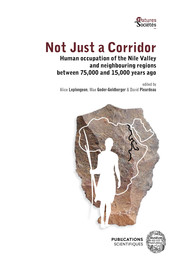Natures en sociétés
- Publisher : Publications scientifiques du Muséum
- Series : Natures en sociétés | 3
- Place of publication : Paris
- Year of publication : 2020
- Published on OpenEdition Books : 20 janvier 2022
- EAN (Print version) : 9782856539316
- Electronic EAN : 9782856539323
- Number of pages : 364 p.
The end of the Pleistocene (c. 75-15 ka) is a key period for the prehistory of the Nile Valley. The climatic fluctuations documented during this period have led human populations from the Middle and Late Palaeolithic to adapt to a changing Nile. In particular, the global shift to more arid conditions regionally translated into the expansion of the Sahara, the lowering of sea levels and the desiccation of some major eastern African lakes. These climatically-induced environmental changes influenced the behaviour of the Nile —although how exactly is still debated— and its role as an ecological refugium for human populations living in its vicinity. Genetic and fossil evidence highlight a strong population substructure in Africa during this period, suggesting the alternation of phases of major dispersals of modern humans within the continent, as well as out-of and back-into Africa, with phases of relative isolation of populations, which might be linked to the creation of environmental refugia during the climatic fluctuations of this period. Understanding to what extent the technological variability observed in north-eastern Africa between 75,000 and 15,000 years ago is linked to environmental changes and/or possible contacts between different human populations is critical in this context. The best-preserved evidence for past human behavior are archaeological assemblages, most often lithic assemblages. However, the use of different terminologies, whether they refer to cultural or techno-typological entities, hampers any systematic comparison between the Nile Valley on one hand and neighbouring regions on the other hand. An outcome of this practice is the artificial ‘isolation’ of the north-eastern African record from its neighbouring regions. This monograph groups together chapters presenting updated reviews and new data on regional archaeological, palaeoenvironmental, palaeoanthropological and geological records from north-eastern Africa, North Africa, the Levant and eastern Africa for the period ranging from 75,000 to 15,000 years ago. While north-eastern Africa, and the Nile Valley in particular, is generally considered as one of the main possible routes of migrations out of Africa, few recent studies allow the data from this region to be viewed from a macro-regional perspective. This book allows the exploration of topical issues, such as modern humans’ capacity for adaptation, particularly in the context of climate change, as well as population interactions and human dispersals in the past, taking a multidisciplinary approach.
PrefaceThe Nile Valley: environmental refugium or corridor of dispersals?
Part 1. The Nile Valley and adjacent deserts
Water, wind, ice and seaPrehistoric environments in the Nile Basin between 75,000 and 15,000 years
De l’eau, du vent, de la glace et la mer : environnements préhistoriques dans le bassin du Nil entre 75 000 et 15 000 ans
Evidence for Pleistocene habitability and occupations in the Western Desert of Egypt, MIS 4 through early MIS 2Indication d’habitabilité et occupation du Désert Occidental de l’Egypte au Pléistocène, depuis le MIS 4 jusqu’au MIS 2
Age of the Late Middle Palaeolithic Nile aggradationThe Khormusan and the Atmur El Kibeish Aterian
Age de l’aggradation du Paléolithique moyen du Nil, du Khormusien et de l’Atérien de l’Atmur El Kibeish
The Sudanese Nile ValleyThe ultimate frontiers of the Aterian and the northern and southern Out of Africa routes of early anatomically modern humans
La Vallée du Nil soudanaise : les frontières finales de l’Atérien et les routes du nord et du sud lors de l’Out of Africa des premiers Hommes anatomiquement modernes
Upper Nubia and beyond during the Terminal PleistoceneNew premises for the late occurrence of the Middle Stone Age
La Haute Nubie et au-delà pendant le Pléistocène terminal — nouveaux prémisses pour la présence tardive du Middle Stone Age
Human occupation density and mobility in the lower Nile Valley(75,000‑15,000 years ago)
Densité d’occupation humaine et mobilité dans la Basse Vallée du Nil (75 000-15 000 ans)
Part 2. Neighbouring regions: North Africa, eastern Africa and the Levant
Cultural transitions in the Middle Stone Age and Later Stone Age records of Northwest AfricaAn overview from Morocco
La transition culturelle entre le Middle Stone Age et le Later Stone Age en Afrique du Nord-Ouest : l’apport des enregistrements du Maroc
Review of chronological data from the Rabat-Témara caves (Morocco)Implications for understanding human occupation in north-west Africa during the Late Pleistocene
Synthèse des données chronologiques des grottes de Rabat-Témara (Maroc) : implications pour la compréhension des occupations humaines en Afrique du Nord-Ouest au cours du Pléistocène récent
Sedimentary and Human Responses to Aridity in Mediterranean CavesThe MIS 4‑2 Record of the Haua Fteah (Cyrenaica, Northeast Libya)
Réponses sédimentaires et adaptations des populations humaines aux phases arides du climat dans les grottes du Bassin méditerranéen : les enregistrements des MIS 4-2 à Haua Fteah (Cyrénaïque, Libye du Nord-Est)
The Middle to Upper Palaeolithic transition as seen from Far’ah II and Boker Tachtit, IsraelDoes it relate to the Nile Valley?
La transition du Paléolithique moyen au Paléolithique supérieure vue depuis Far’ah II et Boker Tachtit, Israël : a-t-elle un lien avec la Vallée du Nil ?
The Lithic Technologies of the Epipalaeolithic Hunter-Gatherers in the Negev, IsraelImplications from Refitting Studies
Les technologies lithiques des chasseurs-cueilleurs épipaléolithiques du Negev, Israël : Implications à partir d’études de remontages
The Horn of Africa at the end of the Pleistocene (75‑12 ka) in its macroregional contextLa Corne de l’Afrique à la fin du Pléistocène (75-12 ka) dans son contexte macro-régional










 Stumble It!
Stumble It!

No comments:
Post a Comment